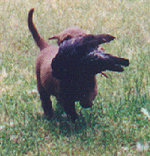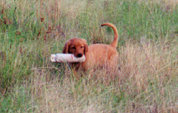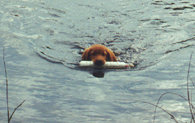 Home Home
 Library Library
 (main page) (main page)
 More on Puppies: More on Puppies:
 Puppy Retrieving: Puppy Retrieving:
 Getting Started Getting Started
 Introducing Birds, Introducing Birds,
 Water, and
Water, and
 Throwers Throwers
|

|
Getting Your Puppy to Come Back
by John and Amy Dahl
First Published by Tri-Tronics, July 1999
Last month we discussed building
retrieving desire, the single most important objective of puppy work. In this column we
give another important tip on maximizing a pup’s focus and motivation, and discuss an
issue which comes up with almost all good puppies: how to get the pup to come back to you.
 When you throw marks for your puppy, it is
very important that you restrain it. Restraining a puppy as retrieves are thrown does a
lot to build desire and eagerness. If you throw while it is loose "at large" it
will not focus or mark nearly so well. At the other extreme, trying to teach a young pup
to be steady will harm its confidence or make it quit retrieving altogether. A young pup
may be easily restrained with a hand in front of its chest.
When you throw marks for your puppy, it is
very important that you restrain it. Restraining a puppy as retrieves are thrown does a
lot to build desire and eagerness. If you throw while it is loose "at large" it
will not focus or mark nearly so well. At the other extreme, trying to teach a young pup
to be steady will harm its confidence or make it quit retrieving altogether. A young pup
may be easily restrained with a hand in front of its chest.

Very young puppies usually
come straight back.
 As your puppy gets bigger, switch to holding
it back by the collar until the dummy is nearly on the ground. You may need to use your
other hand on your puppy’s rear to hold it still in the "sit" position. If
this fails to stop your pup from jumping so wildly that it does not mark the falls, you
may need to do some early steadying work.The wildly flailing pup has convinced itself that
it needs to flail in order to get away from you to make the retrieve. You don’t want
to punish it, only to teach it that flailing is counterproductive. Usually if you quietly
tell it to "sit" and refuse to release it until it does, your puppy will learn
in a few repetitions that sitting still gets it what it wants. If this fails, we recommend
standing on the end of your pup’s check cord, with maybe two feet of slack (make sure
it will not foul your puppy’s feet), telling it to "sit" as you throw, and
making it come back to your side and sit before you release it. Go back to collar
restraint as soon as your pup is watching its marks.
As your puppy gets bigger, switch to holding
it back by the collar until the dummy is nearly on the ground. You may need to use your
other hand on your puppy’s rear to hold it still in the "sit" position. If
this fails to stop your pup from jumping so wildly that it does not mark the falls, you
may need to do some early steadying work.The wildly flailing pup has convinced itself that
it needs to flail in order to get away from you to make the retrieve. You don’t want
to punish it, only to teach it that flailing is counterproductive. Usually if you quietly
tell it to "sit" and refuse to release it until it does, your puppy will learn
in a few repetitions that sitting still gets it what it wants. If this fails, we recommend
standing on the end of your pup’s check cord, with maybe two feet of slack (make sure
it will not foul your puppy’s feet), telling it to "sit" as you throw, and
making it come back to your side and sit before you release it. Go back to collar
restraint as soon as your pup is watching its marks.
 "How can I get my puppy to
come back to me on retrieves?" is probably the most often-asked question in retriever
work. While usually the asker is looking for a short simple answer, in fact getting
puppies to come back is an ongoing challenge that lasts up to the age of six months and
beyond. Most good retriever puppies want to hang on to the retrieve object, especially if
it is a bird, and sooner or later get the idea of not bringing it back to you. A pup may
head the other way with the dummy in its mouth, dance around out of reach, or lie down
with a possessive paw over the dummy (and possibly chew on it). Don’t get angry; this
is a good sign, and perfectly normal. It will, however, require patience and ingenuity to
work through the not-coming-back stage.
"How can I get my puppy to
come back to me on retrieves?" is probably the most often-asked question in retriever
work. While usually the asker is looking for a short simple answer, in fact getting
puppies to come back is an ongoing challenge that lasts up to the age of six months and
beyond. Most good retriever puppies want to hang on to the retrieve object, especially if
it is a bird, and sooner or later get the idea of not bringing it back to you. A pup may
head the other way with the dummy in its mouth, dance around out of reach, or lie down
with a possessive paw over the dummy (and possibly chew on it). Don’t get angry; this
is a good sign, and perfectly normal. It will, however, require patience and ingenuity to
work through the not-coming-back stage.

"Sooner or later most puppies
think of keeping the dummy."
 For little puppies who want to run away, hallway retrieves work well. If you throw the
retrieve object down a hallway, there is nowhere to go but back to you. Sometimes it is
necessary to sit to one side of the hallway, making it look as though your pup has an
opportunity to run past you into the living room, in order to get the puppy to come your
way. Of course, you can reach out at the last minute and capture the pup. If your puppy
holds on to the dummy, pet and praise it for a moment before taking the dummy from its
mouth, in the hope that it won’t equate returning with having its prize snatched
away.
For little puppies who want to run away, hallway retrieves work well. If you throw the
retrieve object down a hallway, there is nowhere to go but back to you. Sometimes it is
necessary to sit to one side of the hallway, making it look as though your pup has an
opportunity to run past you into the living room, in order to get the puppy to come your
way. Of course, you can reach out at the last minute and capture the pup. If your puppy
holds on to the dummy, pet and praise it for a moment before taking the dummy from its
mouth, in the hope that it won’t equate returning with having its prize snatched
away.
 Most puppies should not be trained forcibly to return before they are about six months
old—the cost to their confidence and initiative, and that all-important desire, is
too great. Instead, just engineer a way to get your puppy back. There are a variety of
approaches to try. Sometimes kneeling down, arms wide apart, is enough to attract a puppy.
Praising your pup in an excited tone of voice, clapping your hands, and backing away (or
even turning and looking over your shoulder as you move away) will often get a young
"chewer" to pick up the dummy and run to you. It helps to establish, in separate
sessions, that when you call your pup in an excited tone of voice, it can get praise,
attention, and/or treats by coming to you.
Most puppies should not be trained forcibly to return before they are about six months
old—the cost to their confidence and initiative, and that all-important desire, is
too great. Instead, just engineer a way to get your puppy back. There are a variety of
approaches to try. Sometimes kneeling down, arms wide apart, is enough to attract a puppy.
Praising your pup in an excited tone of voice, clapping your hands, and backing away (or
even turning and looking over your shoulder as you move away) will often get a young
"chewer" to pick up the dummy and run to you. It helps to establish, in separate
sessions, that when you call your pup in an excited tone of voice, it can get praise,
attention, and/or treats by coming to you.
 As your puppy gets older and
bigger, you will want to work outside and try to extend its range, introduce it to
different types of cover, etc. It may require more effort to get a puppy back to you
outdoors, but there are a number of strategies which work in various combinations. Young
pups, up to about three months and sometimes more, usually have a particular place they
want to go to, and if you get between them and it, you can catch them (especially if they
are dragging a check cord). They tend to head for familiar territory. Out in the field,
typically they want to go under the car or truck, so always throw out away from the
vehicle. In such an unfamiliar place, longer falls tend to produce a greater inclination
to come back.
As your puppy gets older and
bigger, you will want to work outside and try to extend its range, introduce it to
different types of cover, etc. It may require more effort to get a puppy back to you
outdoors, but there are a number of strategies which work in various combinations. Young
pups, up to about three months and sometimes more, usually have a particular place they
want to go to, and if you get between them and it, you can catch them (especially if they
are dragging a check cord). They tend to head for familiar territory. Out in the field,
typically they want to go under the car or truck, so always throw out away from the
vehicle. In such an unfamiliar place, longer falls tend to produce a greater inclination
to come back.
 At home, if you are so fortunate as to have part of your yard fenced near the house,
stand by the open gate and throw out away from it. Almost all pups in this situation will
head back for the gate, although as your pup gets older and smarter you may need to stand
far enough to one side for it to think it can dart past you. If you don’t have a
gate, you can try the "head ‘im off at the pass" technique. While any move
toward the pup may trigger a game of keep-away, running on an intercept course
doesn’t seem to—and often you can get away with this ruse for weeks before your
pup figures it out. Avoid chasing your pup; if it gets out of reach, use a combination of
pretending to ignore it and stealth. Dogs love to play "keep away" and you
don’t want your pup to think it can play it with you.
At home, if you are so fortunate as to have part of your yard fenced near the house,
stand by the open gate and throw out away from it. Almost all pups in this situation will
head back for the gate, although as your pup gets older and smarter you may need to stand
far enough to one side for it to think it can dart past you. If you don’t have a
gate, you can try the "head ‘im off at the pass" technique. While any move
toward the pup may trigger a game of keep-away, running on an intercept course
doesn’t seem to—and often you can get away with this ruse for weeks before your
pup figures it out. Avoid chasing your pup; if it gets out of reach, use a combination of
pretending to ignore it and stealth. Dogs love to play "keep away" and you
don’t want your pup to think it can play it with you.
 As your pup gets older, faster, and smarter, and you are working on longer retrieves,
sooner or later you will need a new tactic. If it is warm enough for water work (so that
the water is 60 degrees or more and the air is warm), practice retrieves straight out into
the water. Almost all retrievers swim straight back to shore before trying to head in
another direction. If you meet your puppy at the water’s edge, before it has a chance
to duck away, you may get your feet wet but you will also be able to get the dummy from
its mouth before it can shake, preventing the bad habit of dropping dummies.
As your pup gets older, faster, and smarter, and you are working on longer retrieves,
sooner or later you will need a new tactic. If it is warm enough for water work (so that
the water is 60 degrees or more and the air is warm), practice retrieves straight out into
the water. Almost all retrievers swim straight back to shore before trying to head in
another direction. If you meet your puppy at the water’s edge, before it has a chance
to duck away, you may get your feet wet but you will also be able to get the dummy from
its mouth before it can shake, preventing the bad habit of dropping dummies.
 Retrieving from cover has almost the same effect as retrieving from water, except
the puppy won’t need to shake. Puppies tend to head straight back out of the cover
towards you. The throw may need to be shortened so the pup can find the dummy or bird easily, and
need to be straight into the area of cover, not angled If
you live in an area where foxtails or other grass awns are a problem, you need to be aware
that getting one of these up its nose can be fatal to a dog, so do not send your puppy
into an area where it will have to hunt among them.
Retrieving from cover has almost the same effect as retrieving from water, except
the puppy won’t need to shake. Puppies tend to head straight back out of the cover
towards you. The throw may need to be shortened so the pup can find the dummy or bird easily, and
need to be straight into the area of cover, not angled If
you live in an area where foxtails or other grass awns are a problem, you need to be aware
that getting one of these up its nose can be fatal to a dog, so do not send your puppy
into an area where it will have to hunt among them.

"In the water he thinks about the
shortest route back to shore."
 For land retrieves in medium-short cover, you may need to use a long check cord. We have a 100-foot check cord we use with committed
"runners." We keep throws within this distance, and take up the slack as the
puppy returns. Usually this requires backing up to keep the puppy’s feet from fouling
the cord—a very awkward procedure at first but one most people can learn with
practice. We use braided polypropylene for these cords. If coiled properly, it resists
tangling; it floats and does not fray or rot.
For land retrieves in medium-short cover, you may need to use a long check cord. We have a 100-foot check cord we use with committed
"runners." We keep throws within this distance, and take up the slack as the
puppy returns. Usually this requires backing up to keep the puppy’s feet from fouling
the cord—a very awkward procedure at first but one most people can learn with
practice. We use braided polypropylene for these cords. If coiled properly, it resists
tangling; it floats and does not fray or rot.
 While you can certainly introduce the
"here" command with a young pup and practice it in a controlled situation, we
recommend that you wait until after the pup is six months old to insist on total
reliability. Never command "here" on a retrieve before your pup is reliable,
because if it does not come you are in a no-win situation: you must either allow the pup
to disregard the "here" command, or you must enforce the command in a way which
will punish your puppy for retrieving. Either way you undo a lot of careful work.
While you can certainly introduce the
"here" command with a young pup and practice it in a controlled situation, we
recommend that you wait until after the pup is six months old to insist on total
reliability. Never command "here" on a retrieve before your pup is reliable,
because if it does not come you are in a no-win situation: you must either allow the pup
to disregard the "here" command, or you must enforce the command in a way which
will punish your puppy for retrieving. Either way you undo a lot of careful work.
 We have presented a variety of tactics for getting a puppy to return on a retrieve, all
of which we use regularly. In combination they should work with almost any retriever pup well
enough to enable you to continue its retrieving work, and building up its all-important
retrieve desire until it is old enough to be taught to come reliably when called. Next
month we will continue with puppy training, and discuss introduction to birds, water,
gunfire, and other aspects of adult retriever work.
We have presented a variety of tactics for getting a puppy to return on a retrieve, all
of which we use regularly. In combination they should work with almost any retriever pup well
enough to enable you to continue its retrieving work, and building up its all-important
retrieve desire until it is old enough to be taught to come reliably when called. Next
month we will continue with puppy training, and discuss introduction to birds, water,
gunfire, and other aspects of adult retriever work.
Copyright 1999 by John and Amy Dahl.
First North American electronic serial rights to Tri-Tronics, Inc.
Did you find this article helpful? A revised and expanded version is included in our new book on retriever training, The 10-Minute Retriever.

|








